Diane: Machu Picchu was visually exciting, historically revealing, architecturally staggering, and truly lived up to its reputation. This entry is more scrapbook than diary, so enjoy the pictures. Here's the view upon entry to the site. You can see Wayna Picchu, the big peak on the right.
Off to the left is where our guide said the nobility lived.

Also to the left is the Temple of the Sun. It is the only round building we saw in Machu Picchu. During the June solstice, our guide said that the sunlight lights up the boulder inside. She even showed us a copy of photo of what it looks like on that day. For the most sacred building at the site, this doesn't seem like much of a solar marker.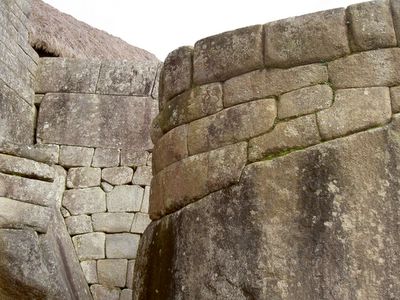
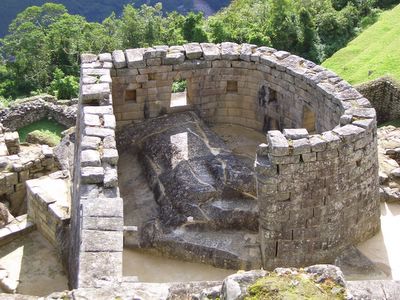
The terraces are in beautiful shape. They never needed to be reconstructed. My guidebook says that this was due to the extensive drainage and support system underneath. It then goes on to say that most of Machu Picchu was built on top of a landfill that was terraced underneath for support.


There are gorgeous views in every direction.
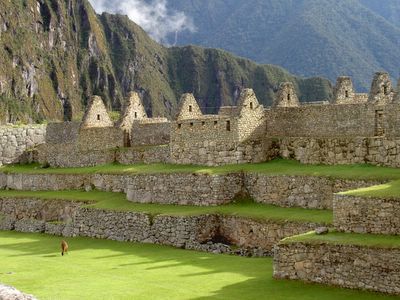

Miki was here 9 years ago. He said that everything was pretty much identical, except that there are a few more areas cordoned off and one or two areas have started falling apart, including the Principle Temple.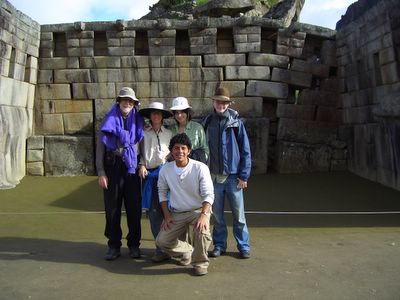
Off the same square as the Principle Temple is the Temple of Three Windows, with windows that make a perfect frame for the not-so-distant mountains.
In the small square itself, there is a kite-shaped stone that our guide said represented the Southern Cross constellation. Climbing up to the top from here, there was a large stone with an impressive name, Hitching Post of the Sun, that our guide said was used to make astronomical observations. She also said it was aligned with all the mountains. No specifics were forthcoming, so I have no idea what this meant. This piece of rock was probably the most-photographed object at the site. Just to leave no sacred stone unturned, at the farthest end of the site, where the climb up Wayna Picchu began, stood the Sacred Rock, purported to have high energy properties and also to mimic the shape of the mountain behind it. I saw one tourist, whose guide gave a detailed demonstration of the ritual touching of the rock, using their hands, face, chest, back, and turning around several times. Even though I tried hard to suspend my disbelief, I couldn't help but turn away and burst out laughing.
My favorite piece of real estate was a home in the Secular Area, where the common people lived. From this home, the views were extraordinary.

Wherever I looked, there was a lot of great stone work.

After a bit of deliberating over what appeared to be an impossible ascent, we decided to hike up Wayna Picchu.
We waited at the entrance for TM's blood sugar to return to normal and had an opportunity to see the sweat-smeared faces and hear the panting of those returning from the walk. The hike up to the top included a steep path of stone steps, cable handrails, and exceptional views.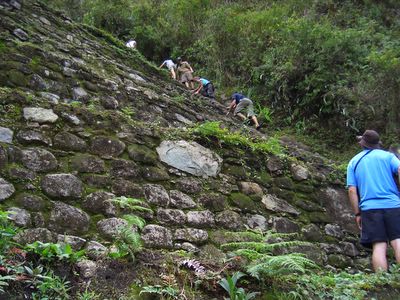

Near the top of the climb, we watched one woman use a rope to climb over a rock slab. She burst out in tears after getting on solid ground. I immediately recognized in her, my own recent episode with fear-of-heights in Vilcabamba. It's nice to know you're not the only one to suffer such irrational feelings, so I went over to share some water and some of my own story. Another woman joined in, who had been scared of heights all her life and was currently on medication to control her anxiety. If we had talked louder, I wonder if we wouldn't have attracted enough people to start a support group. We were all laughing soon enough and I know I felt a lot better.
To make our way to the next site, the Temple of the Moon, we went through a cool tunnel, climbed some of the Incan stone ladder steps up the side of a large rock, clambered down a steep rock face, and then began the steep descent. The Temple of the Moon was built in a natural cave with high-quality Incan stone work. It had fit in precisely with the natural sculptural shape of the existing rock.
It was damp inside, and as a result, there was one rock face covered in moss, that had accumulated a large amount of graffiti over time.
Although TM had been bed-bound for 3 weeks due to back problems, he had rebounded and none of us could keep up with his hiking pace. After reconnecting back at the Sacred Rock, Calliope and Tom found that the energy from the rock was not sufficient enough to reinvigorate them for any new climbs in the area. They went in search of a bathroom and a relaxing spot to have a couple of liters of water. TM, Miki, and I unwittingly headed over to the Caretaker's Hut and then opted to hike to the Inca Bridge. My guidebook says that this hike is only for those who are good with heights. Since I no longer count myself in that category, I am glad that I did not have the foresight to review this section of the guidebook before embarking on the walk. We passed a rainbow, almost always a sure sign that you're on the right path.
Before encountering a bridge, the path petered out into vertical rock, so we lay down on a slab jutting out over the edge.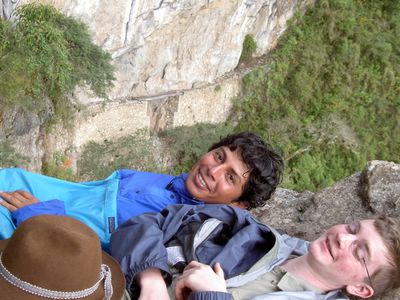
From there we spotted the bridge, which had no apparent function as it petered out into steep impassable terrain. How did they build this bridge anyway?
Upon returning to the Caretaker's Hut, we were treated to a classic view and seemingly powerful photo op that compelled each of us to pose in the same spot.



No comments:
Post a Comment